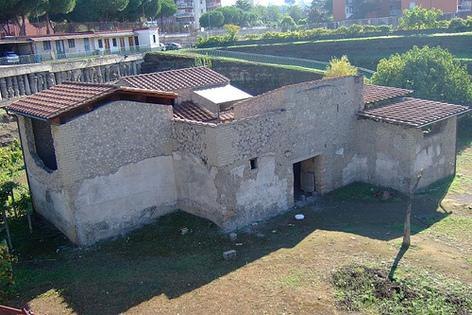The rural villa in the area of Villa Regina comprising various rooms arranged on the three sides of an open courtyard, where there is the wine cellar with 18 dolia.
Among the various areas in the villa of which casts of the wooden fixtures from the doors and windows have been preserved, the following areas and items are of particular interest: a wide arcade surrounding the uncovered courtyard, a space used as storage and temporary kitchen where most of the ornaments of the villa were found on shelves and in a closet, the torcularium with the remains of the wooden press with holes and cockpits for its fastening to the ground, the pressing tank and the container for the must, the triclinium with painted walls attributed to the transition phase between the Third and Fourth styles, the kitchen, which wasn’t being used at the moment of the eruption, with a brick oven and a hearth at the centre of the room, a service compartment with a water cistern topped by a clay puteal, the granary used for the preservation of hay, cereals, and beans, adjacent to the uncovered barnyard.
The villa, which also had an upper floor, can be dated back to the 1st century B.C. in its original form and was expanded in at least two phases during the Augustan and Julio-Claudian age. In the arcade, a transportation wagon (plaustrum) was found during the excavation, and in a street nearby you can still see the tracks left by its wheels on the ground.
The walking surface of the area around the villa is made up of the agricultural land of 79 A.D., which still preserves traces of the ancient plantations and the casts of its vine roots were made. Beside them, the vines were replanted for the demonstrative recreation of the vineyard.
Along the site walls, the stratigraphy of the ground clearly shows the sequence of pyroclastic sediments, caused by the eruption of 79 A.D., which destroyed the small farm.
Here we are in Villa Regina, a rustic villa located in the Ager Pompeianus, at Boscoreale to be precise, which stands one kilometre north of the ancient Excavations of Pompeii. Just as at Pompeii, this villa was buried by the eruption of AD 79. It was excavated recently, in 1977, following urban development works in the area. This villa, like the others at Torre Annunziata, Torre del Greco and Castellammare di Stabia, falls under the jurisdiction of the Archaeological Park of Pompeii. Wide-ranging restoration works were concluded in 2019, having started with the restoration and a philological recovery of the villa’s roofing, restoration of the decorative elements and the consolidation of masonry structures as well as the consolidation of ceramic artefacts and other articles manufactured using concrete and plaster casts which can be found inside and outside the villa. Following the restoration work, which was completed in 2019, and taking advantage of this period of closure of the Villa to the public and visitors, the careful maintenance and ordinary maintenance works continue, these being carried out periodically every six months, whilst extraordinary maintenance is undertaken every two years. The first operations to be carried out are those which follow monitoring. Monitoring involves inspection of the degradation phenomena of the decorated surfaces, as well as of the vegetation of the biological patina, which here just as in many other places and archaeological sites is a constant problem - particularly here, where the Villa is around eight to nine metres below the modern street level. As a consequence of this, capillary rise is a problem, with the recurrent formation and migration to the surface of soluble salts. Monitoring is therefore constant, and the debris of partially coherent deposits such as soil needs to be removed, along with guano deposits. Careful analysis is also required of the artefacts located inside and outside the Villa, such as the terracotta dolia, or the concrete or plaster artefacts used in the creation of casts either of the tree roots or instruments of agricultural production, such as the Torcularium inside the Villa. Extraordinary maintenance operations, on the other hand, are conducted every two years, and involve the consolidation of the plaster, as well as interventions to restore the cohesion of the paint layers and aesthetic redevelopment interventions, which are particularly important for the decorated surfaces such as the Lararium or the frescoes present in the triclinium, which can be attributed to a period between the Third and Fourth Styles. Scheduled maintenance, constant observation and monitoring of degradation phenomena guarantee adequate preventative measures for the conservation of the Villa and all of the surfaces and artefacts preserved within.


